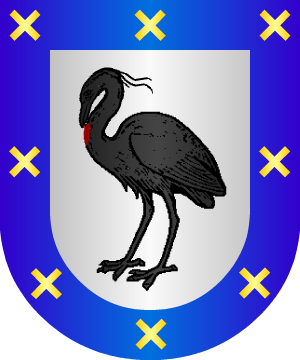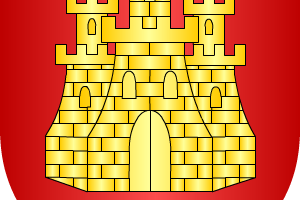The Garcia family has a rich and fascinating history that spans across different continents and centuries. One of the most treasured symbols of their legacy is the Garcia family coat of arms, which has existed for generations. In this article, we will delve into the origin and spread of the Garcia surname, the history of the family crest, notable people with the Garcia surname, and much more. Join us as we uncover the wealthy history of the Garcia family coat of arms and explore the meaning and significance behind this iconic symbol.
Contenido
Origin and Spread of the Garcia Surname
The illustrious past of the surname has spread far and wide, with it being found in countries such as the United States, Peru, Colombia, Argentina, and more. One theory of its beginnings is that it originated from the Basque region of Spain, while others believe it has its roots in the Germanic name Walter or the Latin name Garcia. Regardless of its source, the Garcia surname has become a prominent name in many countries around the world.
The Garcia family’s heritage is represented by their coat of arms, which has been around for centuries. This coat of arms typically features a shield with various symbols and colors that signify different aspects of the family’s history. The symbols on the coat of arms can vary depending on the region and time period, but they usually have a significant meaning. The coat of arms garcia is a symbol of the family’s prosperity and social standing, and it is a symbol of the family’s lengthy and prosperous past.
Garcia Family Origin
he Garcia surname is one of the most common surnames in Spain and Spanish-speaking countries around the world. Its origin is uncertain, and there are several theories about its origin.
One theory suggests that the Garcia surname comes from the Germanic “Warsi” or “Garsi,” which means “spear.” The Visigoths, who invaded the Iberian Peninsula in the 5th century, brought this name with them and adapted it to their language. Over time, the name evolved into “Garcia.”
Another theory suggests that the Garcia surname comes from the Latin “Garsia” or “Garcia,” which means “bear.” It is said that this name was given to people with physical characteristics that resembled a bear.
There is also a theory that suggests that the Garcia surname comes from the Hebrew “Gershom,” which means “foreigner” or “stranger.” It is said that this name was given to Jews who emigrated to Spain during the Middle Ages.
Regardless of its origin, the Garcia surname quickly spread in Spain and Spanish colonies in Latin America during the time of conquest. Today, it is one of the most common surnames in Spain and Spanish-speaking countries around the world.
Popularity of the Garcia Surname
The widespread prevalence of the Garcia surname is undeniable, having been found in numerous countries such as the United States, Peru, Colombia, Venezuela, Argentina, Paraguay, Brazil, and Hispaniola. The name is derived from Portuguese and Spanish, translating to son of Garcia or from a place named Garcia. With its far-reaching distribution, the Garcia name has earned its place in the annals of history.
In Spain, the Garcia surname is the most common, though there are a variety of theories as to its origin. Regardless, the name has been around for centuries and has come to signify Spanish identity. It is also believed that the Garcia family originated in Lucca, Italy, adding an additional layer of complexity to the name’s roots.
The Garcia family crest is an important part of their genealogical heritage and can be found online. It is a symbol of the family’s legacy and has been around for centuries. Those who bear the name can take pride in their ancestry and use the crest to connect with their forebears. With such a long and varied history, it’s no wonder why the Garcia surname has become so popular around the globe.
History of the Garcia Coat of Arms

The history behind the Garcia family coat of arms is uncertain, and there is no precise account of its origin. However, it is known that the use of coats of arms by noble and aristocratic families in Europe dates back to the 12th and 13th centuries.
In the case of the Garcia family, it is believed that their coat of arms was granted to a member of the family as recognition for some achievement or service rendered to the crown or nobility. It is possible that this family member fought in some important battle or played a prominent role in the royal court.
The design of the Garcia family coat of arms, with a black heron in the center and a border with silver asp symbols, is commonly used in other coats of arms of noble and aristocratic families in Spain and other European countries. Each element of the coat of arms has a symbolic meaning that represents the characteristics and values that the family considers important.
In summary, although there is no specific history behind the Garcia family coat of arms, it is believed to have been granted as recognition to a family member for their achievements or services rendered. The design of the coat of arms with the heron in the center and the border with silver asp symbols is common in other coats of arms of noble and aristocratic families in Europe.
Notable People with the Surname Garcia
The Garcia clan has yielded a variety of high-achievers throughout its storied history. Perhaps the most renowned is Hector P. Garcia, a Mexican-American physician who dedicated his life to protecting civil rights and improving healthcare for minorities. He founded the American GI Forum, which fought for the rights of Hispanic veterans, and was awarded the Presidential Medal of Freedom in 1984. Another Garcia luminary is Jerry Garcia, the iconic frontman and lead guitarist of the Grateful Dead. His musicianship earned him a spot in the Rock and Roll Hall of Fame in 1994.
Athletics has also seen its share of prominent Garcias. Roberto Garcia was a professional boxer who won world titles in multiple divisions. After he retired from the ring, he served as both a referee and judge. Jeff Garcia was another athletic Garcia, a four-time Pro Bowl quarterback who led the San Francisco 49ers and the Tampa Bay Buccaneers to the playoffs.
The entertainment industry is also home to several notable Garcias. Andy Garcia is an Academy Award-nominated actor renowned for films like The Godfather: Part III and Ocean’s Eleven. Additionally, he is a director and producer. Jorge Garcia is another actor, best-known for his role as Hugo Hurley Reyes on the television series Lost. He’s also had a number of roles in films and other TV shows.
The list of well-known Garcias is long, and their successes and contributions to their respective fields are a testament to the lasting legacy of this family. It is clear that the Garcia name holds a wealth of potential and has had a lasting impact on the world.
Meaning and Origin of the Garcia Name
The illustrious legacy and meaning of the surname Garcia have been disputed for centuries. This Portuguese and Spanish moniker translates to son of Garcia or someone from a place named Garcia. Additionally, some theories propose that it stands for a courageous warrior or powerful monarch. The Garcia family crest has been preserved through the ages and serves as a reminder of their history, with each symbol and hue signifying something special.
Tracing back to Lucca, Italy, the Garcia surname has spread throughout the world, appearing in countries such as the United States, Peru, Colombia, Venezuela, Argentina, Paraguay, Brazil, and Hispaniola in the 16th century. The Garcia name is the most popular in Spain, prompting several hypotheses on its origin. To gain a better comprehension of this illustrious family’s history, one can research their coat of arms and discover its hidden depths.
Finding the Garcia Family Crest
The Garcia family coat of arms features a black heron or egret in the center, set against a silver background. The heron is a stylized bird with a long, thin neck and a similarly long, pointed beak.
The exact meaning of the heron in the Garcia family coat of arms is not entirely clear, as there are several possible interpretations. One possible explanation is that the heron symbolizes cunning and patience, two qualities that might be valuable for a warrior or a leader. Others interpret the heron as a symbol of vigilance and protection, as these birds are often watchful and careful. It has also been suggested that the heron could represent adaptability and a calm, serene approach to decision-making, as these birds are known for their excellent fishing skills and graceful, skillful movements.
In addition to the heron in the center of the coat of arms, there is a blue border that surrounds the shield, with eight silver Christian symbols known as “aspa” inside. The aspas are believed to represent the eight beatitudes, or blessings, that are mentioned in the Sermon on the Mount in the New Testament. The border itself is a symbol of protection and unity, as it surrounds and unites all the elements of the coat of arms.
In summary, the Garcia family coat of arms with the heron in the center could symbolize a variety of traits, such as cunning, patience, vigilance, protection, adaptability, and serenity. The exact meaning may vary depending on interpretation and family tradition.
Conclusion
In conclusion, the Garcia family coat of arms is a fascinating and valuable part of their genealogical history. The surname’s popularity and spread across various countries only adds to its intrigue. The origin of the Garcia name and family is rooted in Spain and Italy, and notable people with the surname have made significant contributions to their respective fields. The Garcia family crest can be found online, providing an opportunity to delve deeper into their rich history. Overall, the Garcia surname and coat of arms serve as a reminder of the wealth of cultural and historical significance that can be uncovered through genealogical research.

The Unbroken Lineage of Chavez Last Name: Tracing Its Ancestral Roots and Historical Significance

Perez Last Name Origin: Tracing the Ancestral Roots and Cultural Significance of the Name

Fuentes Last Name: Tracing Its Ancestral Roots and Cultural Significance

